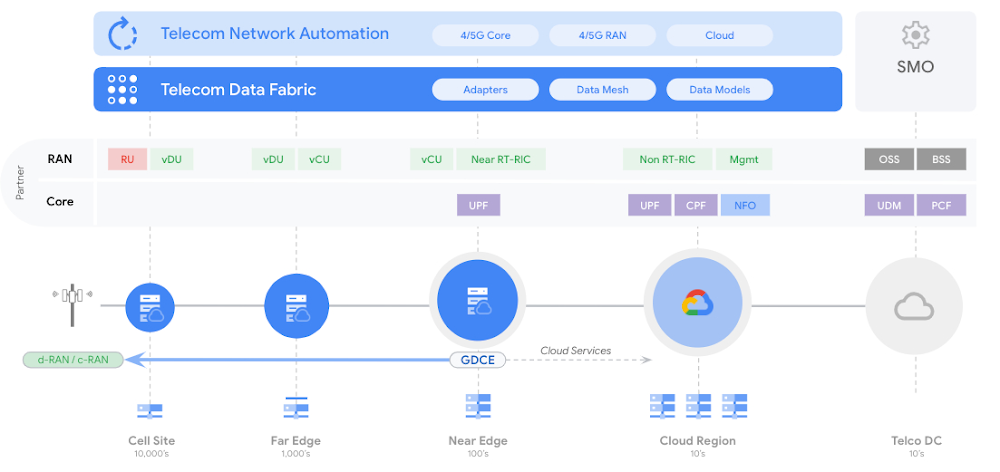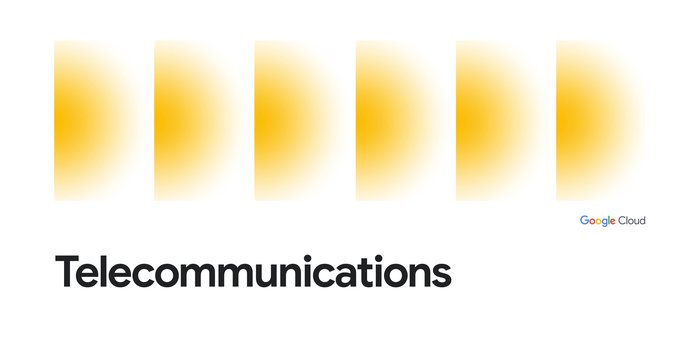Reimagining Radio Access Networks with Google Cloud
Santanu Dasgupta
Product Area Lead - Telecom Access and RAN
DP Ayyadevara
Group Product Manager - Telco Cloud
Try Google Cloud
Start building on Google Cloud with $300 in free credits and 20+ always free products.
Free trialFor the past decade, Communication Service Providers (CSPs) have been busy transforming their mobile network architecture, and the Radio Access Network (RAN) is the final frontier. Today at Mobile World Congress 2023 Barcelona, we announced that we can now run the radio access network functions as software on Google Distributed Cloud Edge, providing CSPs with a common and agile operating model that extends from the core of the network to the edge, for a high degree of programmability, flexibility, and low operating expenses.
CSPs have already embraced open architecture, open-source software, disaggregation, automation, cloud, AI and machine learning, and new operational models, to name a few. The journey started in the last decade with Network Functions Virtualization, primarily with value added services and then deeper with core network applications, and in the past few years, that evolved into a push towards cloud-native. With significant progress in the core, the time for Cloud RAN is now.
However, whether for industry or region-specific compliance reasons, data sovereignty needs, or latency or local data-processing requirements, most of the network functions deployed in a mobile or wireline network may have to follow a hybrid deployment model where network functions are placed flexibly in a combination of both on-premises and cloud regions. RAN, which is traditionally implemented with proprietary hardware, falls into that camp as well.
In 2021, we launched Google Distributed Cloud Edge (GDC Edge), an on-premises offering that extends a consistent operating model from our public Google Cloud regions to the customer’s premises. For CSPs, this hybrid approach makes it possible to modernize the network, while enabling easy development, fast innovation, efficient scale and operational efficiency; all while simultaneously helping to reduce technology risk and operational costs. GDC Edge became generally available in 2022.
The four pillars of our Cloud RAN Solution
Together with today’s launch of Telecom Data Fabric and Telecom Network Automation, support for RAN in GDC Edge marks the beginning of a new era for mobile access; one premised on a world of cloud, AI and automation.
Our RAN strategy is to offer a set of open, innovative, and value-differentiating products and solutions across four pillars: cloud infrastructure, analytics, automation, and partnerships with RAN network function providers. As a proud member of the O-RAN alliance, our solution is built on its reference architecture, and it supports deployments for both vRAN and O-RAN (referred together as Cloud RAN), offering flexibility and a transition path to our customers.


Let’s take a look at some key capabilities delivered by each of the solution pillars in our Cloud RAN framework.
Optimized cloud-native infrastructure
Cloud-native network transformations generally derive enhanced benefits with a hybrid cloud-edge foundation: GDC Edge for on-premises workloads, and Google Cloud for functions that could be served more centrally from a cloud region. Today we also announced advanced capabilities in Google Kubernetes Engine (GKE) that enable native Kubernetes multi-interface networking and traffic acceleration with Network Function Optimizer.
While the solution components like Non-RT RIC, SMO and/or management functions are generally suitable for a cloud region based deployment, our Cloud RAN platform leans heavily on GDC Edge to help run critical network functions of RAN on the customer premises, providing key capabilities across both software and hardware:
Multiple network generations - CSPs are iteratively modernizing their networks with Non-Stand-Alone (NSA) and SA strategies. To support multiple network generations, GDC Edge supports various frequency TDD and FDD bands in the low, mid, and mmWave, with support for both standard and massive MIMO configurations.
Flexible deployment models - GDC Edge can deliver a consistent cloud-native platform with a fully O-RAN compliant disaggregated network that consists of virtual central units (vCU) and virtual distributed units (vDU). Deployment models can now support centralized (C-RAN) and distributed (D-RAN) topologies. CSPs can choose the right deployment model depending on their constraints, including fiber or real estate availability, bandwidth requirements, and distance / latency constraints.
Form-factor cost optimization - Site-specific deployment requirements may pose constraints such as compute density, equipment depth and access restrictions, environmental hardening, power, cooling, and more. GDC Edge provides flexible rack and scaled-down footprints for C-RAN and D-RAN use cases that can extend the cloud footprint to the cell sites.
Performance and scale - GDC Edge is designed to be a highly available and high-performance platform that will support various redundancy mechanisms to ensure control and network data-plane availability. GDC Edge offers Intel Xeon CPUs with advanced instruction sets, multiple AVX-512 SIMDs per CPU core and Enhanced Platform Awareness in the Kubernetes environment, helping to ensure a high-performance data plane. GDC Edge’s optimized host EdgeOS can enable an option for a real-time kernel that helps ensure performance that can be as good as bare metal, with deterministic predictability and low latency. For L1 acceleration, the use of either a lookaside accelerator or a full inline-L1 accelerator helps deliver the performance requirements of the real-time vDU network function, while offering flexibility to our NF partners and customers.
Time synchronization - Time synchronization (TS) is a foundational requirement for RAN. GDC Edge infrastructure offers this capability to help enable various O-RAN compliant D-RAN & C-RAN deployment models, through a host of platform software capabilities in combination with hardware capabilities enabled by TS-enabled NICs, network underlay devices and other techniques.
GDC Edge for Cloud RAN leverages Google’s two decades of experience building hyperscale, horizontally scaling infrastructure with comprehensive automation, lifecycle management, and SRE-based ops across the cloud platform stack. Relevant Google Cloud data privacy and security practices can be extended into the overall stack, spanning application, network, storage, and supply-chain workflows.
Integrated data fabric for advanced analytics
A data-driven intelligent network can help CSPs achieve operational efficiencies and cost reductions. CSPs can leverage near-real-time intelligence to help enhance network performance, improve the customer experience, and enhance network efficiency to drive sustainability initiatives.
Today we announced Telecom Data Fabric, which can enable a simplified data-management platform experience, accelerate a fast path to high-value data, and power control-loop automations. The cloud-based service empowers a hybrid cloud-edge analytical capability, helping to bring standardization across legacy and emerging O-RAN O1 and O2 interfaces. Data from multi-vendor network function providers can be transformed into a common data model, helping to allow analytics application providers to develop insights and control-loop automation. A RAN-specific marketplace of AI models and applications (rApps for Non-RT RIC and xApps for Near-RT RIC) drive reusability to deliver predictive intelligence and just-in-time RAN optimizations to help enhance network performance, subscriber quality of experience, energy efficiency, and many other use cases.
Intent-based automation and control
Automating a comprehensive set of lifecycle management use cases for the platform, infrastructure, workloads, and the end-to-end service at large scale is a baseline requirement for Cloud RAN to help deliver on desired efficiency, reliability, and TCO reduction goals. The new Telecom Network Automation is an integral component of Google Cloud’s cloud-native network modernization offering for CSPs, and employs intent-driven, declarative automation to help address both infrastructure and network functions at scale for both lifecycle management and optimization. An advanced control-loop based automation system converges and helps streamline the deployment, scale, and optimization of O-RAN compliant components, driving towards more simplified autonomous networks.
To deliver this automation, our network function ecosystem partners are working within the Nephio initiative, which aims to advance Kubernetes-compliant CRDs and Operators, and meets O-RAN interface specifications including O2, O2-IMS, O2-DMS, and O1.
Ecosystem partnerships with network function providers
While open industry standards and new innovation can be core to a successful RAN cloudification strategy; Strategic partnerships with network function providers are at the center of our CSP network modernization strategy, and Cloud RAN is no exception.
CSPs around the world have asked us to build a solution that is open and multi-vendor capable. In close collaboration with our Cloud RAN partners, we are pre-integrating, testing and validating a full-stack solution to help reduce the integration burden on CSPs and make our joint solutions easy to deploy, manage, and operate. Here are what our partner executives have to say about our collaborations -
Ericsson - “Cloud RAN will add scalability and flexibility to a service provider’s 5G network and help them evolve to open network architectures. Our collaboration with Google Cloud on their GDC Edge for Near and Far edge deployments will help CSPs adopt Cloud RAN as part of their network evolution.” - Oscar Toorell, Head of Technology, Engineering Unit Cloud RAN, Ericsson
Mavenir - “Open RAN is accelerating the transformation of 5G RAN to a cloud-native, virtualized and automated network that can leverage the benefits of both core and edge cloud infrastructure. Mavenir’s fully containerized solution leverages the flexibility of Google Cloud and GDC Edge, with the built-in hardware acceleration of the latest generation of CPUs, to offer CSPs more capacity, performance and energy efficiency in the Open RAN components; as well as better operational efficiency, scalability and reliability with am AI/ML powered RIC that automates non-realtime and near-real time network optimizations.” - Jane Shen, Vice President of Technology Strategy, Mavenir
Nokia - “A collaborative approach to Cloud RAN means that we can drive efficiency, innovation, openness, and scale by jointly delivering competitive advantage to organizations embracing Cloud RAN. Together with our leading industry partners, we have made huge progress towards this goal by driving consistent performance across any partner's cloud infrastructure or server hardware.” - Pasi Toivanen, Head of Partner Cloud RAN Solutions at Nokia
In conclusion, a software-defined RAN transformation is top of mind for CSPs. Google Cloud is partnering with CSPs and network equipment vendors to bring a comprehensive set of products and solutions across cloud infrastructure, analytics, automation, security, and operational practices, that can help the CSPs reimagine the radio access network. We are very excited imagining the possibilities and opportunities ahead around CSP and mobile network architecture transformation, and how that can help our customers. We are working with multiple leading CSPs with these products and solutions, and will share more updates during the coming months. To learn more about our Cloud RAN vision and offerings, reach out to your Google Cloud representative.


